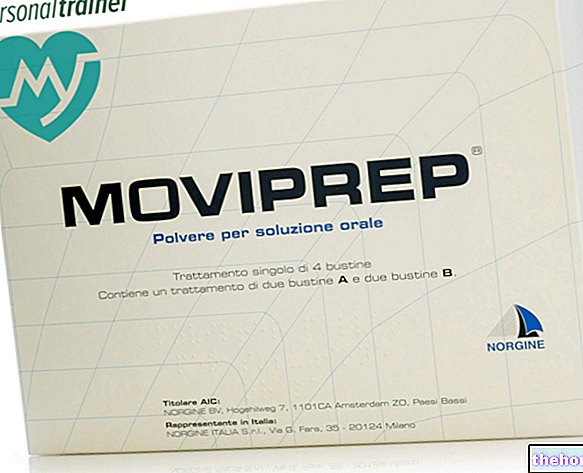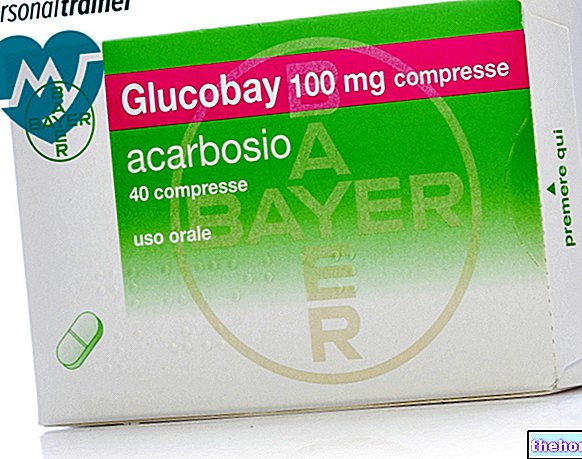Active ingredients: Adapalene
DIFFERIN 0.1% Gel
DIFFERIN 0.1% Cream
Why is Differin used? What is it for?
The "adapalene, active ingredient contained in Differin, belongs to the category of retinoids, chemical compounds linked to Vitamin A. E" indicated for the local treatment (application on the skin) of acne vulgaris with comedones (punctate skin reliefs), papules (small raised lesions of the skin without pus) and pustules (small lesions of the skin that contain pus).
It is suitable for the treatment of acne of the face, chest and back.
Contraindications When Differin should not be used
Do not use Differin:
- if you are allergic to adapalene or any of the other ingredients of this medicine (listed in section 6).
- if you are pregnant or if you suspect a pregnancy (see section "Pregnancy and breast-feeding")
Precautions for use What you need to know before taking Differin
Talk to your doctor or pharmacist before using Differin.
Avoid contact with eyes, mouth, corners of the nose or mucous membranes.
If the medicine gets into your eyes, rinse them immediately with plenty of warm water. Avoid applying the medicine to broken skin (cuts or abrasions), burned or eczematous skin (a "skin inflammation), and in case of severe acne that has spread to large areas of the body.
Avoid excessive exposure to sunlight or UV radiation (tanning lamps). When exposure cannot be avoided, you should use sunscreen products and protective clothing on the treated areas.
Stop using the medicine immediately if you experience a sensitization reaction or severe irritation.
Children and adolescents
The safety and efficacy of adapalene has not been evaluated in children below 12 years of age.
Interactions Which drugs or foods can change the effect of Differin
Tell your doctor or pharmacist if you are taking, have recently taken or might take any other medicines.
- There are no known interactions with other medicines used topically together with Differin; however, do not use the medicine together with other retinoids or medicines with the same mechanism of action.
- Absorption of adapalene through the skin is low and therefore interaction with other medicinal products not for local use is unlikely. There is no evidence that local use of adapalene affects the efficacy of oral medicines such as contraceptives (used to prevent pregnancy) or antibiotics (used to treat infections).
- Differin can cause local irritation. If Differin is used simultaneously with exfoliating agents (which remove dead skin cells), abrasive cleansers, strong drying agents, astringents or irritants (containing aromatic or alcoholic agents), the "irritating effect may be greater. However, acne skin treatments, such as erythromycin solutions (up to 4%), clindamycin phosphate (1% as base) or aqueous gels of benzoyl peroxide up to 10% can be used in the morning if Differin is applied in the evening.
Warnings It is important to know that:
Pregnancy and breastfeeding
If you are pregnant or breast-feeding, think you may be pregnant or are planning to have a baby, ask your doctor or pharmacist for advice before using this medicine.
Do not use Differin during pregnancy as it is possible a very low absorption of adapalene through the skin.
In case of an unexpected pregnancy, stop the treatment immediately.
Differin can be used during breastfeeding. To avoid exposing the infant by contact, avoid applying Differin to the breast.
Driving and using machines
Differin does not affect the ability to drive and use machines.
Differin Gel contains:
- Methyl parahydroxybenzoate (E218) which can cause allergic reactions (including delayed)
- Propylene glycol which can cause skin irritation.
Differin Cream contains:
- Methyl parahydroxybenzoate and propyl parahydroxybenzoate which can cause allergic reactions (even delayed).
Dose, Method and Time of Administration How to use Differin: Posology
Always use this medicine exactly as described in this leaflet or as directed by your doctor or pharmacist. If in doubt, consult your doctor or pharmacist.
You should apply Differin to the acne affected areas once a day after washing and drying the skin thoroughly. Apply only a thin layer of gel or cream avoiding contact with the eyes, lips, mucous membranes and corners of the nose.
The recommended daily dose is about 3 finger-tip units (2 g of total product weight), which corresponds to the amount needed to treat all potentially affected areas (the whole face, shoulders, upper part chest and upper back).
A finger-tip unit is the amount squeezed from the tube onto the surface of the first phalanx of the index finger.
Do not use astringent cosmetics or cosmetics that favor the formation of comedones (pinpoint skin reliefs).
The doctor will re-evaluate the therapy after 12 weeks.
Overdose What to do if you have taken too much Differin
If you apply too much Differin, it will not have better or faster results and severe redness, peeling or discomfort of the skin may occur.
You should not take Differin by mouth.
If you accidentally take a large amount of Differin, tell your doctor immediately or go to the nearest hospital.
If you have any further questions on the use of this medicine, ask your doctor or pharmacist.
Side Effects What are the side effects of Differin
Like all medicines, Differin can cause side effects, although not everybody gets them.
The following side effects are listed in order of frequency:
Common (may affect up to 1 in 10 people)
- dry skin
- skin irritation
- burning sensation
- erythema (skin irritation)
Uncommon (may affect up to 1 in 100 people)
- contact dermatitis (inflammatory skin reaction)
- skin discomfort
- sunburn
- itch
- exfoliation
- acne
Side effects with frequency not known *
- allergic dermatitis (allergic contact dermatitis)
- skin pain
- swelling
- irritation of the eyelids
- erythema of the eyelids
- itchy eyelids
- swelling of the eyelids
* Post-marketing pharmacovigilance data
Skin irritation is reversible by reducing the frequency of treatment or stopping it.
Reporting of side effects
If you get any side effects, talk to your doctor or pharmacist. This includes any possible side effects not listed in this leaflet.Side effects can also be reported directly via the national reporting system at www.agenziafarmaco.it/it/responsabili. By reporting side effects you can help provide more information on the safety of this medicine.
Expiry and Retention
Keep this medicine out of the sight and reach of children.
Do not use this medicine after the expiry date which is stated on the package. The expiry date refers to the last day of that month.
The expiry date refers to the unopened, correctly stored medicine.
Differin 0.1% Cream: This medicine does not require any special storage conditions.
Differin 0.1% Gel: do not freeze.
Do not throw any medicines via wastewater or household waste. Ask your pharmacist how to throw away medicines you no longer use. This will help protect the environment.
Other information
What Differin 0.1% Gel contains
- The active ingredient is adapalene. 100 g of gel contain adapalene 0.1 g
- The other ingredients are carbomer, propylene glycol, poloxamer 182, disodium edetate, methyl parahydroxybenzoate, phenoxyethanol, sodium hydroxide to adjust the pH to 5, purified water.
What Differin 0.1% Cream contains
- The active ingredient is adapalene. 100 g of cream contain adapalene 0.1 g
- The other ingredients are carbomer 934P, Peg-20 methyl glucose sesquistearate, glycerol, natural squalane, methyl parahydroxybenzoate, propyl parahydroxybenzoate, disodium edetate, methyl glucose sesquistearate, phenoxyethanol, cyclomethicone, sodium hydroxide to adjust the pH to 6.5 + 0.2 , purified water.
What Differin looks like and contents of the pack
Gel for skin use, 30 g tube.
Cream for skin use, 30 g tube.
Source Package Leaflet: AIFA (Italian Medicines Agency). Content published in January 2016. The information present may not be up-to-date.
To have access to the most up-to-date version, it is advisable to access the AIFA (Italian Medicines Agency) website. Disclaimer and useful information.
01.0 NAME OF THE MEDICINAL PRODUCT
DIFFERIN
02.0 QUALITATIVE AND QUANTITATIVE COMPOSITION
Differin 0.1% Gel
100 g of gel contain:
Active principle:
Adapalene 0.1 g
Excipients with known effects: methyl parahydroxybenzoate, propylene glycol
Differin 0.1% Cream
100 g of cream contain:
Active principle:
Adapalene 0.1 g
Excipients with known effects: methyl parahydroxybenzoate, propyl parahydroxybenzoate
For the full list of excipients, see section 6.1
03.0 PHARMACEUTICAL FORM
Gel.
Cream.
04.0 CLINICAL INFORMATION
04.1 Therapeutic indications
Adapalene is indicated for the cutaneous treatment of acne vulgaris where comedones, papules and pustules predominate. It is suitable for the treatment of acne of the face, chest and back.
04.2 Posology and method of administration
Apply Differin 0.1% Gel and Differin 0.1% Cream on acne affected areas once a day, after washing the skin. Apply a thin film of gel or cream avoiding contact with eyes, lips, mucous membranes and corners of the nose (see section 4.4 Special warnings and precautions for use). Make sure affected areas are dry before application.
The maximum recommended daily dose is about 2 g of total product weight, which corresponds to 3 finger-tip units, the amount needed to treat all potentially affected areas (the whole face, shoulders, upper chest and the upper back).
A finger-tip unit is the amount squeezed from the tube onto the surface of the first phalanx of the index finger.
Therapy should be re-evaluated after 12 weeks of treatment.
In the event that it is necessary to reduce the frequency of application or to temporarily stop treatment, the frequency of application can be resumed or therapy resumed, once it is established that the patient is able to tolerate the treatment again.
Any cosmetics used by patients must not be comedogenic and astringent.
The safety and efficacy of adapalene have not been evaluated in children younger than 12 years.
04.3 Contraindications
Hypersensitivity to the active substance or to any of the excipients listed in section 6.1.
The product must not be used during confirmed or suspected pregnancy (see section 4.6 Pregnancy and Lactation).
04.4 Special warnings and appropriate precautions for use
Should a severe sensitization or irritation reaction occur, discontinue use of the medicinal product.
Patients should be advised to use the medicinal product less frequently or to temporarily or completely stop application if the degree of local irritation justifies it.
Avoid contact with eyes, mouth, corners of the nose or mucous membranes. Should the product come into contact with the eyes, rinse immediately with lukewarm water. Avoid applying the product on damaged skin (cuts or abrasions) or on burnt or eczematous skin and in patients with severe acne extended to large surfaces of the body.
Exposure to the sun and artificial UV rays, including tanning lamps, should be avoided while using adapalene. When exposure cannot be avoided, the use of sunscreen products and protective clothing on the treated areas is recommended.
Women of childbearing potential should be advised of the potential risk of reproductive toxicity (see section 4.6 Pregnancy and Lactation).
Differin gel contains:
• Methyl parahydroxybenzoate (E218) which can cause allergic reactions (even delayed).
• Propylene glycol which can cause skin irritation.
Differin cream contains
• Methyl parahydroxybenzoate and propyl parahydroxybenzoate which can cause allergic reactions (even delayed).
04.5 Interactions with other medicinal products and other forms of interaction
There are no known interactions with other medicines used topically and concomitantly with Differin 0.1% Gel and Differin 0.1% Cream; however, do not use other retinoids or drugs having the same mechanism of action concomitantly with adapalene.
Adapalene is essentially stable to oxygen, light and is not chemically reactive. Although extensive animal and human studies have demonstrated the absence of phototoxic or photoallergic potential for adapalene, the safety of using adapalene during repeated exposure to sunlight or UV radiation has not been confirmed in either animals or humans. "man." Excessive exposure to sunlight or UV radiation should be avoided.
Absorption of adapalene through human skin is low (see section 5.2 Pharmacokinetic properties), and therefore interaction with systemic medicinal products is unlikely. There is no evidence that the efficacy of oral medicines, such as contraceptives or antibiotics, can be affected by the topical use of adapalene.
Differin 0.1% Gel and Differin 0.1% Cream have a potential for slight local irritation; it is therefore possible that the simultaneous use of peeling agents, abrasive cleansers, strong drying agents, astringents or irritating products (aromatic or alcoholic agents) may produce an additional irritant effect. However, anti-acne skin treatments, such as erythromycin solutions (up to 4 %) or clindamycin phosphate (1% as base) or aqueous gels of benzoyl peroxide up to 10%, can be used in the morning when adapalene is applied in the evening as there is no mutual degradation or cumulative irritation.
04.6 Pregnancy and breastfeeding
Pregnancy
Studies conducted on orally treated animals have shown reproductive toxicity at high systemic exposures (see section 5.3 Preclinical safety data).
Clinical experience with applied adapalene and locally applied benzoyl peroxide in pregnancy is limited, however the limited data available did not indicate any dangerous effects on the pregnancy or on the health of the fetus that was exposed in early pregnancy.
As there are limited data available and a very weak passage of adapalene through the skin is also possible, it is recommended not to use Differin during pregnancy.
In the event of an unexpected pregnancy, treatment should be discontinued.
Feeding time
No clinical studies have been conducted to investigate whether the medicinal product is excreted in animal or human milk following application of Differin to the skin..
However, no effects on breastfed infants are expected as systemic exposure of lactating women to Differin is negligible.
Differin can therefore be used in breastfeeding. To avoid contact exposure of the infant, the application of Differin to the breast by breastfeeding women should be avoided.
04.7 Effects on ability to drive and use machines
Differin does not affect the ability to drive and use machines.
04.8 Undesirable effects
Differin can cause the following adverse reactions:
* Post-marketing pharmacovigilance data
Skin irritation is reversible when treatment is reduced in frequency or stopped.
Reporting of suspected adverse reactions
Reporting of suspected adverse reactions occurring after authorization of the medicinal product is important as it allows continuous monitoring of the benefit / risk balance of the medicinal product. Healthcare professionals are asked to report any suspected adverse reactions via the national reporting system. "address www.agenziafarmaco.gov.it/it/responsabili.
04.9 Overdose
Differin 0.1% Gel and Differin 0.1% Cream should not be taken orally and are for cutaneous use only. If the medicine is applied in an excessive quantity, there will be no better or faster results, while marked redness, peeling or discomfort may occur.
The acute oral dose of Differin 0.1% Gel and Differin 0.1% Cream required to produce toxic effects in mice and rats is greater than 10 mg / kg. However, unless the amount accidentally ingested is small, appropriate gastric lavage should be considered.
05.0 PHARMACOLOGICAL PROPERTIES
05.1 Pharmacodynamic properties
Pharmacotherapeutic group: Retinoids for the topical treatment of acne, ATC code: D10AD03
Adapalene is a retinoid-like compound which, in in vivo and in vitro inflammation models, has been shown to possess anti-inflammatory properties; adapalene is essentially stable to oxygen and light and is chemically non-reactive. Mechanistically, adapalene binds, like tretinoin, to specific nuclear retinoic acid receptors but, unlike tretinoin, not to cytosolic receptor binding proteins.
Adapalene, applied topically, is comedolytic in the rhino mouse model and also has effects on the abnormal processes of epidermal keratinization and differentiation, both present in the pathogenesis of acne vulgaris. The mechanism of action of adapalene is proposed in a normalization of cell differentiation follicular epithelial, which results in a reduced formation of the microcomedo.
Adapalene is superior to reference retinoids in standard anti-inflammatory tests conducted both in vivo and in vitro. Mechanistically, it inhibits the chemotactic and chemokinetic response of human polymorphonuclear leukocytes and also the metabolism of arachidonic acid directed to proinflammatory mediators via lipoxidation. This profile suggests that the cell-mediated inflammatory component present in acne may be modified by adapalene. Studies in human patients provide clinical evidence that cutaneous adapalene is effective in reducing the inflammatory components of acne (papules and pustules).
05.2 Pharmacokinetic properties
Absorption of adapalene through human skin is low; in clinical studies, following chronic topical application of adapalene to large areas of acne-prone skin, no measurable plasma levels were found with an analytical sensitivity of 0.15 ng / mL . After administration of [14C] adapalene in rats (IV, IP, oral and topical), rabbits (IV, oral and topical) and dogs (IV and oral), the radioactivity was distributed in various tissues; the highest levels were found in the liver, spleen, adrenal glands and ovaries. Metabolism in animals has been identified experimentally and occurs mainly by O-demethylation, hydroxylation and conjugation, and excretion occurs mainly via the biliary route.
05.3 Preclinical safety data
In animal studies, adapalene was well tolerated after topical application for up to 6 months in rabbits and up to two years in mice. The main symptoms of toxicity found in all animal species after oral administration are related to hypervitaminosis A syndrome, and include bone dissolution, elevated alkaline phosphatase, and mild anemia. Large oral doses of adapalene produced no adverse neurological, cardiovascular or respiratory effects in animals. Adapalene is not mutagenic. Life span studies with adapalene were completed in mice at cutaneous doses of 0.6, 2 and 6 mg / kg / day and in rats at oral doses of 0.15, 0.5 and 1.5 mg / kg / day. die. The only significant finding was a statistically significant increase in benign pheochromocytomas of the medullary portion of the adrenal gland in male rats that received adapalene at a dose of 1.5 mg / kg / day. This variation is not considered relevant to the cutaneous use of adapalene.
06.0 PHARMACEUTICAL INFORMATION
06.1 Excipients
Differin 0.1% Gel
Carbomer, propylene glycol, poloxamer 182, disodium edetate, methyl parahydroxybenzoate, phenoxyethanol, sodium hydroxide to adjust the pH to 5, purified water to complete the formulation.
Differin 0.1% Cream
Carbomer 934P, Peg-20 methyl glucose sesquistearate, glycerol, natural squalane, methyl parahydroxybenzoate, propyl parahydroxybenzoate, disodium edetate, methyl glucose sesquistearate, phenoxyethanol, cyclomethicone, sodium hydroxide to adjust the pH to 6.5 0.2 and purified water to complete the wording.
06.2 Incompatibility
None known.
06.3 Period of validity
Differin 0.1% Cream: 3 years
Differin 0.1% Gel: 3 years.
06.4 Special precautions for storage
Differin 0.1% Cream: This medicine does not require any special storage conditions.
Differin 0.1% Gel: do not freeze.
06.5 Nature of the immediate packaging and contents of the package
Differin 0.1% Gel is packaged in 30g white low density polyethylene tubes fitted with a white polypropylene screw cap.
Differin 0.1% Cream is packaged in 30 g aluminum tubes lined with an epoxy-phenolic resin and fitted with a white polypropylene screw cap.
Not all pack sizes may be marketed.
06.6 Instructions for use and handling
No special instructions
07.0 MARKETING AUTHORIZATION HOLDER
Galderma Italia S.p.A.
Via dell "Annunciata, 21 - Milan
08.0 MARKETING AUTHORIZATION NUMBER
Differin 0.1% Gel 30 g tube - AIC 029309034
Differin 0.1% Cream 30 g tube - AIC 029309046
09.0 DATE OF FIRST AUTHORIZATION OR RENEWAL OF THE AUTHORIZATION
Date of first authorization: Differin 0.1% Gel - AUGUST 1996 /
Differin 0.1% Cream - JANUARY 2000 /
Date of most recent renewal: November 2014
10.0 DATE OF REVISION OF THE TEXT
AIFA determination of 17/02/2017




























